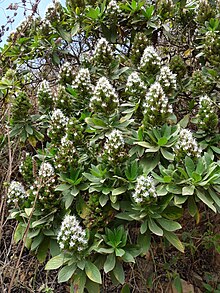Echium hypertropicum
| Echium hypertropicum | |
|---|---|

| |
| Echium hypertropicum at Ribeira Principal in Santiago Island | |
| Scientific classification | |
| Kingdom: | Plantae |
| Clade: | Tracheophytes |
| Clade: | Angiosperms |
| Clade: | Eudicots |
| Clade: | Asterids |
| Order: | Boraginales |
| Family: | Boraginaceae |
| Genus: | Echium |
| Species: | E. hypertropicum
|
| Binomial name | |
| Echium hypertropicum Webb, 1849
| |
Echium hypertropicum is a species of flowers that belong to the Boraginaceae family. The species are endemic in Cape Verde and is listed as endangered by the IUCN.[1][2] Its last form of the scientific name is related to being inside the tropics.[2]
Together with Echium vulcanorum and Echium stenosiphon, its local name is lingua de vaca (cowtongue or cow-tongue) because of the texture of the leaves.[3] By its γ-linolenic acid, the plant are used for medicinal and dietary purposes.[4]

Variation
Old plants higher than 0.5–1 m are extremely rare today.[2]
Distribution and ecology
Artemisia gorgonum are founded in the Sotavento islands of Santiago (in the area of Ribeira Principal) and Brava. It is mainly occurring in the subhumid and humid zones, but it has also been reported from the arid zone on Santiago.[2]
Other
Echium hypertropicum can be founded at Jardim Botânico Nacional Grandvaux Barbosa in São Jorge dos Órgãos in eastern Santiago Island.
References
- ^ a b "Echium hypertropicum". The IUCN Red List of Threatened Species. 3.1. IUCN. 2017. Retrieved February 13, 2018.
- ^ a b c d Romeiras, Maria M.; Cotrim, Helena C.; Duarte, Maria C.; Pais, Maria S. (2007). "Genetic diversity of three endangered species of Echium L. (Boraginaceae) endemic to Cape Verde Islands". Biodiversity and Conservation. 16. Springer: 547–566. doi:10.1007/s10531-006-6734-0.
{{cite journal}}: Cite has empty unknown parameters:|month=,|quotes=, and|coauthors=(help) - ^ Gomes et al 2003, p. 16
- ^ Gomes, Alda Roque; Vasconcelos, Teresa; Almeida, Helena Guimarães de (31 October 2008). "Plantas na medicina tradicional de Cabo Verde" [Traditional Medicinal Plants in Cape Verde] (PDF) (in Portuguese). Plantas Medicinais e Fitoterapêuticas nos Trópicos, IICT/CCCM. p. 7.
{{cite web}}: Italic or bold markup not allowed in:|publisher=(help)
Further reading
- Isildo Gomes et al., Endemic plants and indigenous trees of the Cape Verde Islands, Ministry of Environment, Agriculture and Fishery and the Projects Conservation and Exploration of the Natural Resources on the Island Fogo (Deutsche Gesellschaft für Technische Zusammenarbeitand) and Conservation of Biodiversity, 2003, p. 22
- Maria M. Romeiras, Helena C. Cotrim, Maria C. Duarte et Maria S. Pais, Genetic diversity of three endangered species of Echium L. (Boraginaceae) endemic to Cape Verde Islands, in Biodiversity & Conservation, vol. 16, no. 2, p. 547-566
- Schmidt, Johann Anton (1852). Beiträge zur Flora der Cap Verdischen Inseln. p. 66.
- The endemic vascular plants of the Cape Verde Islands, W Africa, Sommerfeltia 24, 1997, C. Brochmann, Ø. H. Rustan, W. Lobin & N. Kilian, ISSN 0800-6865, ISBN 82-7420-033-0
External links
- "Echium stenosiphon". Universal Biological Indexer and Organizer (UBIO). Retrieved 23 May 2012.

